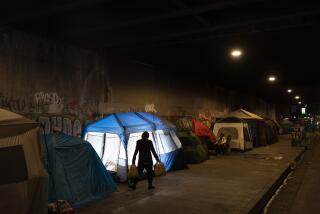Gazing into Inglewood’s mirror
- Share via
A COUPLE OF WEEKS ago, as I was driving somewhat hurriedly to the Target in Inglewood to begin my holiday shopping in earnest, I saw a homeless man. This is an increasingly common sight around town, but it almost made me brake. The man was trudging east up Century Boulevard toward Crenshaw, leaning into a cold wind. Large bundles were laced to his back, and his arms were folded tightly, as if to keep body and soul -- to say nothing of his belongings -- together. What struck me was his urgency, that despite his apparent destitution he was moving, slowly but purposefully. He was not camped on a street corner or left-turn island, begging for money. His effort to simply keep going moved me.
What struck me next was that he should have been able to stay put, especially here in Inglewood. Of course, government everywhere in this wealthy country should aid its least fortunate citizens, and the fact that it continually doesn’t -- or won’t -- is a well-documented disgrace. But what stopped me that day was the even more troubling fact that an African American man -- a demographic entirely overrepresented among the homeless -- had so clearly not found succor in a city with a primarily African American government and a middle class to match, one of the only such places in Los Angeles County.
In the same moment, I recognized that the black middle class is part of the problem. Unlike its white counterpart in, say, Santa Monica (with its model homeless programs) or even in downtown lofts, Inglewood’s middle class is precarious and always has been. It has always lived next to poverty and crime, because those conditions exist in black communities everywhere. Despite its numbers, the black middle class is still emerging, struggling to distinguish itself from an underclass that grows larger as the blue-collar middle -- the real middle class -- shrinks. People in Inglewood may truly want to help their own homeless, but that wish must somehow coexist with a suburban anxiety about maintaining property values and the look, if not the reality, of prosperity.
The hard fact is, folks in Santa Monica can view their homeless more charitably because they are clearly the other. The homeless there are part of the scenery, not the community, and though they may be considered a nuisance, they are not a real threat to the city’s long-established good life. In Inglewood, the black homeless (and the jobless, and the dangerously underemployed) are a mirror we are loathe to look into, a prod to our collective conscience about how far we have to go before we can count ourselves safely among the fabled American middle class, with all the social equilibrium and freedom of mind it implies.
Martin Luther King Jr. repeatedly said that none of us is free until all of us are free, and though he was speaking in the largest of metaphors, he was also speaking to the quotidian freedoms that describe daily life and make it worthwhile -- riding in the front of the bus, getting served at a lunch counter.
Freedom has evolved since the 1960s to mean more subtle, though less describable, things. The freedom of having a Target in your neighborhood, for instance: It sounds frivolous, until you consider that Target offers goods that all but the poorest of us can afford. Living decently no longer means not having to be a sharecropper but not having to go without health coverage. By such modern measures black people are still perilously unfree; we cannot breathe easy, and it is this knowledge that keeps the middle class so ambivalent about signs of poverty and lack of success -- homelessness being the most vivid.
In the car, battling my own bout of middle-class asphyxiation, I thought about pulling over. I thought about giving the man money, or asking him what was wrong or, if I was truly courageous, offering to take him somewhere. But when I looked in my rear-view mirror, he had already moved on.
More to Read
Sign up for Essential California
The most important California stories and recommendations in your inbox every morning.
You may occasionally receive promotional content from the Los Angeles Times.













